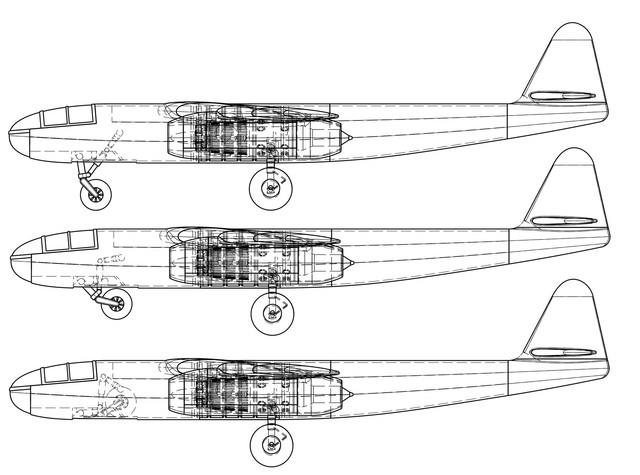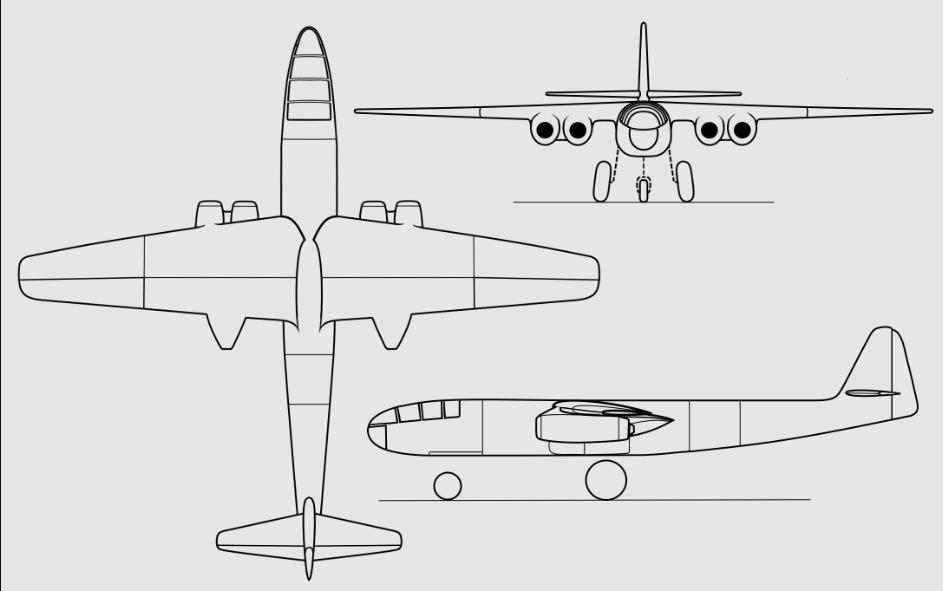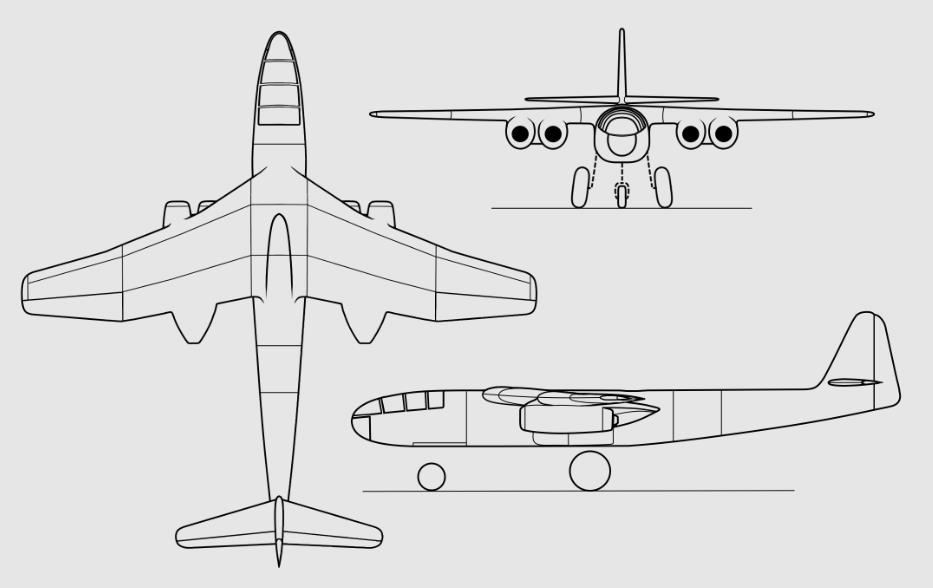| Type | Two seat bomber |
| Engine | 4 Heinkel HeS 109-011 or Junkers Jumo 109-012 |
| Dimensions | Length 16,85 m , height 5,30 m , span 17,60 m, wing area 40,0 m2 , |
| Weights | Empty 9450 kg, loaded 15800 kg , max. take off weight |
| Performance | Max.. speed 887 km/h at 6000 m , cruising speed , range 1500 km, endurance , service ceiling 14500 m , climb |
| Armament | 2 2 x 20 mm MG 151 /20 , 1 13 mm MG 131 anti-aircraft gun, max 3,000 kg bomb load |



In 1943, the Ar 234, which was under development at Arado and was designed as a reconnaissance aircraft, was also wanted to be made into a fast bomber for use by the Luftwaffe , but due to the small size of the aircraft, it was not possible to add a large payload , which is required for an efficient bomber. Thus, Arado thought about ways to improve the Ar 234's ability to carry larger payloads. As a result, in August 1943, it was decided at Arado to develop an enlarged version of the Ar 234, which would make it possible to fill these deficiencies that limited the Ar 234's operational capability. This new project was given the name E.395, and according to the drawings, the new aircraft was almost identical to the Ar 234, only larger in size.
Alongside this, a version was also developed that utilized the Crescent-type arrow wings developed in connection with the E.560 project , which was running at the same time at Arado , which aimed to increase the performance of the jet-powered aircraft at high speeds. Except for the wings, the version in question was identical to the previous version. These plans for a newly developed version were immediately put into use when RLM launched a design competition for a new jet bomber only a month later, in which Arado also participated.
In September 1943, the RLM set out requirements for a new long-range jet bomber capable of bombing the British Isles, and solicited tenders from Junkers, Arado and Blohm & Voss , thus launching a jet bomber design competition. Arado entered the competition with his E.395 proposal, placing the straight-wing version as the primary candidate, and the swept-wing version as a secondary option. Arado's purpose was to seek interest and a better place in the competition with the reliable structure of the aircraft type it nominated. Because of this, the arrow wing version was only an addition and not a priority, because arrow wings were still a relatively new concept at the time, with not much practical evidence, meaning a higher risk of investing in that model. Junkers' candidate in the competition was EF.122 with inverted arrow wings , and Blohm & Voss' even more special P.188 with W-wings .
Even though Arado's proposal was structurally the most reliable option compared to competing models and met all performance requirements, Junkers still had to provide more evidence and evidence to support the profitability and features of its own proposal. In addition, Junkers at that time had the world's largest network of aviation industry research facilities and wind tunnels in addition to its huge industrial production capacity, which is why Junkers' proposal rose ahead of others in terms of profitability in the competition. Blohm & Voss's proposal, on the other hand, was seen to contain several risks, especially in its wing structure and technical operating principle, which caused it to quickly fall out of the competition.
In January 1944, at the end of the competition, Junkers' EF.122 was declared the winner, and Junkers was awarded a contract to continue the development work, which resulted in the development of the Ju 287 . As for Aradon's E.395 and Blohm & Voss's P.188, development work was stopped and they were no longer worked on after this, leaving the projects only in the design phase.
However, later in January 1944, the RLM stated that it also needed a more traditional and simple jet-bomber in addition to the comparatively complex Ju 287, and Arado's E.395 proposal could no longer be accepted, having already been rejected once by the RLM, which is why the RLM sent a notice to Heinkel to immediately design a new jet bomber based on the Ar 234, utilizing the information and design work already gathered at Arado in the E.395 project. Aradon being a fully state-owned company, they were ordered to hand over all documents related to the E.395 project to Heinkel for their own development. After Heinkel received all the documents related to the E.395 project, the development work to design a new jet bomber began immediately. As a result, Heinkel developed a bomber very similar to the Aradon Ar 234, which received the official designation He 343 . However, this aircraft model remained only in the design phase, and the development work was not continued because, despite Heinkel's requests, all government funding was concentrated on the development of the Ju 287.
Externally, the Arado E.395 was practically identical to the Ar 234, but only larger in size. Internally, however, the individual machine had more noticeable differences compared to its predecessor, such as the two-seater pressurized cockpit in the front of the machine, which in the Ar 234 was only one-seater. For bombing , a Lofte 7D telescopic bombing sight was installed in the cockpit , with a BZA aiming computer also connected . The plane's radio equipment included FuG XP operating on MF and HF frequencies and FuG 16 ZY transmitter-receivers operating on VHF frequencies, a Fu Bl II navigation system utilizing radio beams, and a FuG 25 transponder . There were two fuel tanks behind the cockpit, which, however, left space for the main landing gear retractable into the frame. The capacity of these fuel tanks was a total of 4,500 kg of fuel, but it was also possible to install hanging fuel tanks on the plane, which could be dropped if desired, and using these the plane could be filled with a total of 7,000 kg of fuel. Right behind the fuel tanks, it was also possible to install reconnaissance cameras inside the fuselage, which could have been used to conduct reconnaissance flights.
The dimensions of the straight-winged version were planned to be 16.85 meters long, 5.30 meters high and 17.6 meters between the tips . The three-wheel racks that function as landing gear can also be found on the Ar 234 , whose wheels were all retracted inside the plane's frame. To assist the landing, the plane's wings were also equipped with ailerons . The power source was to install either four HeS 011A or Jumo 012 tubojets attached in pairs under the wings. The armament consists of two permanently mounted front and rear firing 20 mm MG 151 aircraft cannons, one pair in each direction, and a single downward-pointing 13 mm MG 131 machine gun with periscope aiming. In addition to these, the payload included 1,500 kg of flying bomb cargo , which could be increased to 3,000 kilograms if the amount of fuel was reduced.
Alongside this, a version was also developed that utilized the Crescent-type arrow wings developed in connection with the E.560 project , which was running at the same time at Arado , which aimed to increase the performance of the jet-powered aircraft at high speeds. Except for the wings, the version in question was identical to the previous version. These plans for a newly developed version were immediately put into use when RLM launched a design competition for a new jet bomber only a month later, in which Arado also participated.
In September 1943, the RLM set out requirements for a new long-range jet bomber capable of bombing the British Isles, and solicited tenders from Junkers, Arado and Blohm & Voss , thus launching a jet bomber design competition. Arado entered the competition with his E.395 proposal, placing the straight-wing version as the primary candidate, and the swept-wing version as a secondary option. Arado's purpose was to seek interest and a better place in the competition with the reliable structure of the aircraft type it nominated. Because of this, the arrow wing version was only an addition and not a priority, because arrow wings were still a relatively new concept at the time, with not much practical evidence, meaning a higher risk of investing in that model. Junkers' candidate in the competition was EF.122 with inverted arrow wings , and Blohm & Voss' even more special P.188 with W-wings .
Even though Arado's proposal was structurally the most reliable option compared to competing models and met all performance requirements, Junkers still had to provide more evidence and evidence to support the profitability and features of its own proposal. In addition, Junkers at that time had the world's largest network of aviation industry research facilities and wind tunnels in addition to its huge industrial production capacity, which is why Junkers' proposal rose ahead of others in terms of profitability in the competition. Blohm & Voss's proposal, on the other hand, was seen to contain several risks, especially in its wing structure and technical operating principle, which caused it to quickly fall out of the competition.
In January 1944, at the end of the competition, Junkers' EF.122 was declared the winner, and Junkers was awarded a contract to continue the development work, which resulted in the development of the Ju 287 . As for Aradon's E.395 and Blohm & Voss's P.188, development work was stopped and they were no longer worked on after this, leaving the projects only in the design phase.
However, later in January 1944, the RLM stated that it also needed a more traditional and simple jet-bomber in addition to the comparatively complex Ju 287, and Arado's E.395 proposal could no longer be accepted, having already been rejected once by the RLM, which is why the RLM sent a notice to Heinkel to immediately design a new jet bomber based on the Ar 234, utilizing the information and design work already gathered at Arado in the E.395 project. Aradon being a fully state-owned company, they were ordered to hand over all documents related to the E.395 project to Heinkel for their own development. After Heinkel received all the documents related to the E.395 project, the development work to design a new jet bomber began immediately. As a result, Heinkel developed a bomber very similar to the Aradon Ar 234, which received the official designation He 343 . However, this aircraft model remained only in the design phase, and the development work was not continued because, despite Heinkel's requests, all government funding was concentrated on the development of the Ju 287.
Externally, the Arado E.395 was practically identical to the Ar 234, but only larger in size. Internally, however, the individual machine had more noticeable differences compared to its predecessor, such as the two-seater pressurized cockpit in the front of the machine, which in the Ar 234 was only one-seater. For bombing , a Lofte 7D telescopic bombing sight was installed in the cockpit , with a BZA aiming computer also connected . The plane's radio equipment included FuG XP operating on MF and HF frequencies and FuG 16 ZY transmitter-receivers operating on VHF frequencies, a Fu Bl II navigation system utilizing radio beams, and a FuG 25 transponder . There were two fuel tanks behind the cockpit, which, however, left space for the main landing gear retractable into the frame. The capacity of these fuel tanks was a total of 4,500 kg of fuel, but it was also possible to install hanging fuel tanks on the plane, which could be dropped if desired, and using these the plane could be filled with a total of 7,000 kg of fuel. Right behind the fuel tanks, it was also possible to install reconnaissance cameras inside the fuselage, which could have been used to conduct reconnaissance flights.
The dimensions of the straight-winged version were planned to be 16.85 meters long, 5.30 meters high and 17.6 meters between the tips . The three-wheel racks that function as landing gear can also be found on the Ar 234 , whose wheels were all retracted inside the plane's frame. To assist the landing, the plane's wings were also equipped with ailerons . The power source was to install either four HeS 011A or Jumo 012 tubojets attached in pairs under the wings. The armament consists of two permanently mounted front and rear firing 20 mm MG 151 aircraft cannons, one pair in each direction, and a single downward-pointing 13 mm MG 131 machine gun with periscope aiming. In addition to these, the payload included 1,500 kg of flying bomb cargo , which could be increased to 3,000 kilograms if the amount of fuel was reduced.








